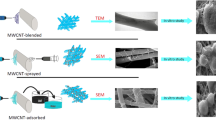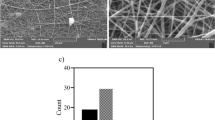Abstract
Keratin has the potential to improve biocompatibility and bioactivity of polymeric nanofibers. However, the addition of keratin into the blend nanofiber would decrease the mechanical properties of nanofibers due to the poor spinnability of keratin, and caused inhomogeneous distribution of keratin inside the nanofibers. Therefore, polymeric nanofibers surface-modified with keratin nanoparticles would improve the hydrophility and mechanical property. In this study, keratose (oxidative keratin, KOS) nanoparticles-coating PVA nanofibers (KNPs/PVA) were fabricated by electrospray deposition after electrospinning and acted on neural cells. The chemical conformation, mechanical properties and wettability of KNPs/PVA nanofibers were characterized. The KNPs/PVA nanofibers provided better wettability and stronger mechanical properties compared to KOS/PVA blend nanofibers at the same mass ratio of KOS to PVA. Furthermore, KNPs/PVA nanofibers displayed better cyto-biocompatibility in terms of cell morphology, adhesion and proliferation compared with PVA nanofibers and KOS/PVA blend nanofibers. These results suggested that polymeric nanofibers surface-modified with KOS nanoparticles can provide superior wettability, mechanical properties and biocompatibility by comparison with the blend nanofibers.








Similar content being viewed by others
References
Evans GR, Brandt K, Widmer MS, Lu L, Meszlenyi RK, Gupta PK, et al. In vivo evaluation of poly(L-lactic acid) porous conduits for peripheral nerve regeneration. Biomaterials. 1999;20:1109–15.
Gu X, Ding F, Williams DF. Neural tissue engineering options for peripheral nerve regeneration. Biomaterials. 2014;35:6143.
Konofaos P, Ver Halen JP. Nerve repair by means of tubulization: past, present, future. J Reconstr Microsurg. 2013;29:149.
Guo T, Ren P, Hao S, Wang B. The underestimated role of mechanical stimuli in brain diseases and the related in vitro models. Curr Pharm Des. 2017;23:2161–76.
Subramanian A, Krishnan UM, Sethuraman S. Development of biomaterial scaffold for nerve tissue engineering: biomaterial mediated neural regeneration. J Biomed Sci. 2009;16:108.
Dang M, Saunders L, Niu X, Fan Y, Ma PX. Biomimetic delivery of signals for bone tissue engineering. Bone Res. 2018;6:25. https://doi.org/10.1038/s41413-018-0025-8.
Ai J, Kiasat-Dolatabadi A, Ebrahimi-Barough S, Ai A, Lotfibakhshaiesh N, Norouzi-Javidan A, et al. Polymeric scaffolds in neural tissue engineering: a review. Arch Neurosci. 2014;1:15–20.
Barnes CP, Sell SA, Boland ED, Simpson DG, Bowlin GL. Nanofiber technology: designing the next generation of tissue engineering scaffolds. Adv Drug Deliv Rev. 2007;59:1413–33.
Wang X, Yucel T, Lu Q, Hu X, Kaplan DL. Silk nanospheres and microspheres from silk/pva blend films for drug delivery. Biomaterials. 2010;31:1025–35.
Alhosseini SN, Moztarzadeh F, Mozafari M, Asgari S, Dodel M, Samadikuchaksaraei A. et al. Synthesis and characterization of electrospun polyvinyl alcohol nanofibrous scaffolds modified by blending with chitosan for neural tissue engineering. Int J Nanomed. 2012;7:25–34. https://doi.org/10.2147/ijn.s25376.
Cui WG, Li XH, Zhou SB, Weng J. Degradation patterns and surface wettability of electrospun fibrous mats. Polym Degrad Stab. 2008;93:731–8. https://doi.org/10.1016/j.polymdegradstab.2007.12.002.
Tang-Schomer MD, White JD, Tien LW, Schmitt LI, Valentin TM, Graziano DJ. et al. Bioengineered functional brain-like cortical tissue. Proc Natl Acad Sci USA. 2014;111:13811–6. https://doi.org/10.1073/pnas.1324214111.
Gomes S, Rodrigues G, Martins G, Henriques C, Silva JC. Evaluation of nanofibrous scaffolds obtained from blends of chitosan, gelatin and polycaprolactone for skin tissue engineering. Int J Biol Macromol. 2017;102:1174–85.
Niu X, Fan R, Tian F, Guo X, Li P, Feng Q. et al. Calcium concentration dependent collagen mineralization. Mat Sci Eng C Mater Biol Appl. 2017;73:137–43. https://doi.org/10.1016/j.msec.2016.12.079..
Lee H, Noh K, Lee SC, Kwon I-K, Han D-W, Lee I-S, et al. Human hair keratin and its-based biomaterials for biomedical applications. Tissue Eng Regen Med. 2014;11:255–65.
Rouse JG, Dyke MEV. A review of keratin-based biomaterials for biomedical applications. Materials. 2010;3:999–1014.
Wang J, Hao S, Luo T, Cheng Z, Li W, Gao F, et al. Feather keratin hydrogel for wound repair: preparation, healing effect and biocompatibility evaluation. Colloids Surf B Biointerfaces. 2017;149:341–50.
Wang J, Hao S, Luo T, Zhou T, Yang X, Wang B. Keratose/poly (vinyl alcohol) blended nanofibers: fabrication and biocompatibility assessment. Mater Sci Eng C. 2017;72:212–9.
Hill P, Brantley H, Dyke MV. Some properties of keratin biomaterials: kerateines. Biomaterials. 2010;31:585.
Reichl S. Films based on human hair keratin as substrates for cell culture and tissue engineering. Biomaterials. 2009;30:6854–66.
Sierpinski P, Garrett J, Ma J, Apel P, Klorig D, Smith T, et al. The use of keratin biomaterials derived from human hair for the promotion of rapid regeneration of peripheral nerves. Biomaterials. 2008;29:118–28.
de Guzman RC, Saul JM, Ellenburg MD, Merrill MR, Coan HB, Smith TL, et al. Bone regeneration with BMP-2 delivered from keratose scaffolds. Biomaterials. 2013;34:1644–56.
Pace LA, Plate JF, Smith TL, Van Dyke ME. The effect of human hair keratin hydrogel on early cellular response to sciatic nerve injury in a rat model. Biomaterials. 2013;34:5907–14.
Burnett LR, Rahmany MB, Richter JR, Aboushwareb TA, Eberli D, Ward CL, et al. Hemostatic properties and the role of cell receptor recognition in human hair keratin protein hydrogels. Biomaterials. 2013;34:2632–40.
Tran CD, Mututuvari TM. Cellulose, chitosan, and keratin composite materials. Controlled drug release. Langmuir. 2015;31:1516–26.
Katoh K, Shibayama M, Tanabe T, Yamauchi K. Preparation and properties of keratin–poly(vinyl alcohol) blend fiber. J Appl Polym Sci. 2010;91:756–62.
Sow WT, Lui YS, Ng KW. Electrospun human keratin matrices as templates for tissue regeneration. Nanomedicine. 2013;8:531–41.
Park M, Kim B-S, Shin HK, Park S-J, Kim H-Y. Preparation and characterization of keratin-based biocomposite hydrogels prepared by electron beam irradiation. Mater Sci Eng C Mater Biol Appl. 2013;33:5051–7.
Aluigi A, Zoccola M, Vineis C, Tonin C, Ferrero F, Canetti M. Study on the structure and properties of wool keratin regenerated from formic acid. Int J Biol Macromol. 2007;41:266–73.
Johnson G, Jope RS. The role of microtubule‐associated protein 2 (MAP‐2) in neuronal growth, plasticity, and degeneration. J Neurosci Res. 1992;33:505–12.
Liedtke W, Edelmann W, Bieri PL, Chiu F-C, Cowan NJ, Kucherlapati R, et al. GFAP is necessary for the integrity of CNS white matter architecture and long-term maintenance of myelination. Neuron. 1996;17:607–15.
Oestreicher AB, De Graan PN, Gispen WH, Verhaagen J, Schrama LH. B-50, the growth associated protein-43: modulation of cell morphology and communication in the nervous system. Prog Neurobiol. 1997;53:627–86.
Engler AJ, Sen S, Sweeney HL, Discher DE. Matrix elasticity directs stem cell lineage specification. Cell. 2006;126:677–89.
Acknowledgements
The authors acknowledge the financial assistance provided by the National Natural Science Foundation of China [Grant No. 31600770], Chongqing Research Program of Basic Research and Frontier Technology (Grant No. cstc2018jcyjAX0836), and the Fundamental Research Funds for the Central Universities [Grant Nos. 106112017CDJXY230006 and 106112018CDQYSG0007].
Author information
Authors and Affiliations
Corresponding authors
Ethics declarations
Conflict of interest
The authors declare that they have no conflict of interest.
Additional information
Publisher’s note: Springer Nature remains neutral with regard to jurisdictional claims in published maps and institutional affiliations.
Rights and permissions
About this article
Cite this article
Guo, T., Yang, X., Deng, J. et al. Keratin nanoparticles-coating electrospun PVA nanofibers for potential neural tissue applications. J Mater Sci: Mater Med 30, 9 (2019). https://doi.org/10.1007/s10856-018-6207-5
Received:
Accepted:
Published:
DOI: https://doi.org/10.1007/s10856-018-6207-5




